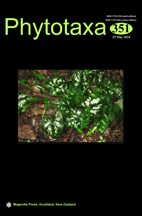Abstract
While analyzing the fossil diatom flora in one of the longest paleolimnological records (core PI-6) from Lake Petén-Itzá, lowland Guatemala, we encountered Aulacoseira Thwaites, Cyclotella (Kützing) and Discostella (Cleve & Grunow) Houk & Klee species appearing successively in the record. Among them, two new species that are assigned to the genus Cyclotella are described herein. Cyclotella petenensis sp. nov. is characterised by a coarse striation marked by a shadow line and a tangentially undulate central area with an arc of central fultoportulae. Cyclotella cassandrae sp. nov. has an elliptically shaped valve, coarse striae and a scattered ring of central fultoportulae in the central area. Classification and differences to similar taxa in the genus Cyclotella are discussed.

